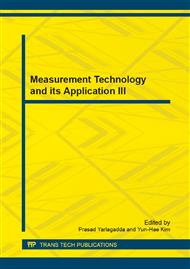[1]
G. Ghinea, G. -M. Muntean, P. Frossard, M. Etoh, F. Speranza, and H. Wu. Special issue on quality issues on mobile multimedia broadcasting[J]. IEEE Trans. Broadcast., (2008) vol. 54, no, 3, pp.424-727, Sep.
DOI: 10.1109/tbc.2008.2004258
Google Scholar
[2]
G. Vasiliadis, S. Antonatos, M. Polychronakis, E.P. Markatos, and S. Ioannidis, Gnort: High Performance Network Intrusion Detection Using Graphics Processors, in Proc. RAID, (2008), pp.116-134.
DOI: 10.1007/978-3-540-87403-4_7
Google Scholar
[3]
Giorgos Vasiliadis and Sotiris Ioannidis. GrAVity: a massively parallel antivirus engine. Recent Advances in Intrusion Detection, 79-96. Springer. (2010).
DOI: 10.1007/978-3-642-15512-3_5
Google Scholar
[4]
Naga Govindaraju, Jim Gray, Ritesh and Dinesh Manocha. GPUTeraSort: High Performance Graphics Coprocessor Sorting for Large Database Management. ACM SIGMOD (2006).
DOI: 10.1145/1142473.1142511
Google Scholar
[5]
Patrick Kurp, Green Computing, Commons. Of the Association for Computing Machinery, (2008), 51(10): 11-13.
Google Scholar
[6]
Pharr M, Fernando R. GPU Gems2. Boston: Addison Wesley, (2005), 493-495.
Google Scholar
[7]
R. Ge, X. Feng, S. Song, H. Chang, D. Li, K. Cameron, PowerPack: energy profiling and analysis of high-performance systems and applications. IEEE Transactions on Parallel and Distributed Systems, (2010), Vol. 21, No. 5, pp.658-671.
DOI: 10.1109/tpds.2009.76
Google Scholar
[8]
Y. Jiao, H. Lin, P. Balarji. et al. Power and Performance Characterization of Computational Kernel on the GPU[C]. IEEE/ACM Int'l Conference on Green Computing and Communications& Int'l Conference on Cyber, Physical and Social Computing. (2010).
DOI: 10.1109/greencom-cpscom.2010.143
Google Scholar
[9]
Sunpyo Hong, Hyesoon Kim, An Integrated GPU Power and Performance Model, In Proceeding of the 37 th annual international Symposium on Computer Architecture, (2010), p.280~289.
Google Scholar
[10]
M.Z. Shaikh, M. Gregoire, W. Li, M. Wroblewski, S. Simon, In situ Power Analysis of General Purpose Graphical Processing Unit, In 19th International Euromicro Conference on Parallel, Distributed and Network-Based Processing. (2011).
DOI: 10.1109/pdp.2011.67
Google Scholar
[11]
Moorthy A.K. Seshadrinathan,K. et al. Wireless Video Quality Assessment: A Study of Subjective Scores and Objective Algorithms[J] IEEE Transaction on Circuits and Systems for Video Technology. (2010) Vol. 20(4), pp: 587-599.
DOI: 10.1109/tcsvt.2010.2041829
Google Scholar
[12]
Paul, Manoranjan; Weisi Lin, Chiew Tong Lau, Bu-sung Lee. Direct Intermode Selection for H. 264 Video Coding Using Phase Correlation. [J] IEEE Transaction on Image Processing. (2011), Vol. 20(2), pp: 461-473.
DOI: 10.1109/tip.2010.2063436
Google Scholar


